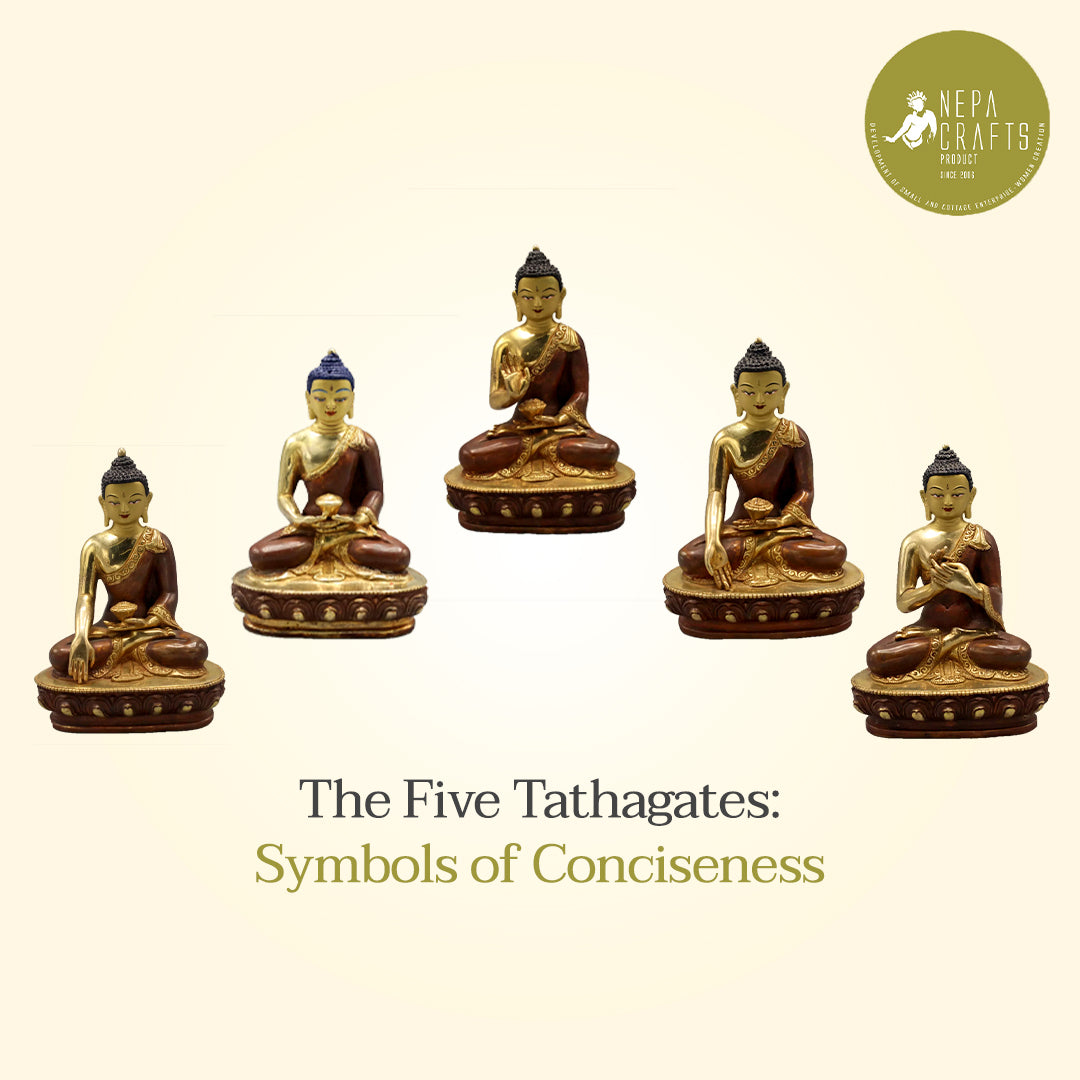
The Five Tathagatas: Symbols of Conciseness
Enlightenment is beyond conceptual understanding and can only be experienced when our mind reaches higher levels of consciousness. However, throughout the ages, many Buddhist movements have tried to explain it through symbolic and visual expressions of the enlightened state. The visualization of The Five Tathāgatas is one of those attempts to explain enlightenment. The five tathagatas are basically Five Dhyani Buddhas. They are also known as Wisdom Buddhas or Jina Buddhas (Jinas).
According to the Vajrayana philosophy of Buddhism, the world is composed of five cosmic elements and they are symbolized by the Five Tathagatas. Different sources have provided different names for these Five Dhyani Buddhas, but nowadays, the most commonly used ones are; Akshobhya, Ratnasambhava, Vairocana, Amitābha, and Amoghasiddhi.
These Five Dhyani Buddhas are often venerated together and are considered a path to enlightenment. Each Dhyani Buddha has a specific color, symbol and posture (Mudras), and represents a different aspect of enlightened consciousness. Let’s discuss each of these Dhyani Buddhas in detail.
-
Akshobhya Buddha: Immovable One

Akshobhya Buddha is the head of the Vajra family (Kula). Akshobhaya was a monk who strive for a long time before becoming a Buddha. He had taken a vow not to feel anger or disgust toward another being, and as he was immovable from this vow, he was later known as Akshobhaya - the Immovable One. Akshobhya Buddha reigns over the Eastern paradise, which is called Abhirati. It is believed that those who fulfill the vow of Akshobhya are reborn in Abhirati.
If you see an Akshobhya Buddha Statue or its picture, you will find him sitting in Bhumisparsha Mudra, a posture where the right hand slightly touches the ground, with the middle finger. Akshobhaya Buddha represents wisdom and knowledge to the mortal, humility and reduced aggression.
- Family (Kula): Vajra Family
- Color: Blue
- Element: Water
- Season: Winter
- Symbol: Vajra
- Mudra: Bhumisparsha Mudra - Earth Touching
-
Amitabha Buddha - Infinite Light

Amitabha Buddha, also known as Amita or Amida Buddha, is the popular among the five Dhyani Buddhas. He is the head of the Padma (Lotus) family. Amitabha was a king who left his kingdom to become a monk. He practiced diligently for five eons and reached higher levels of consciousness, eventually becoming a buddha. Amitabha Buddha is believed to provide a defining of one's self and offer wisdom of observation. He has the quality of overpowering and conquering the mortals.
Amitabha Buddha reigns over the Western paradise, which is called Sukhavati (Pure Land). Amitabha’s portrayals, whether it’s an image or an Amitabha Buddha Statue, all have simplicity and archetypal quality to them. Amitabha Buddha sits in a mediation pose where the right-hand palm is rested on the left-hand palm, with both the hands resting flat on the lap. Amitabha Buddha is usually depicted in red color, and in Tibetan Buddhism, red is the color of love, compassion, and emotional energy.
- Family (Kula): Padma (Lotus) Family
- Color: Red
- Element: Fire
- Season: Summer
- Symbol: Lotus
- Mudra: Dhyana Mudra
-
Amoghasiddhi Buddha - Almighty Conqueror

Amoghasiddhi Buddha is the head of the Karma family. His name means Almighty Conqueror. Amoghasiddhi represents the accomplishment of all action and it is believed that he is the antidote to envy and jealousy. It motivates us to engage fearlessly in liberative activities. He is also believed to be the protector of the world and its creation.
This Dhyani Buddha reigns over the Northern paradise, and if see an Amoghasiddhi Buddha statue, you would find him sitting in Abhaya Mudra, the Mudra of Fearlessness. In this Mudra, the right hand is held at chest level, facing outwards away from the body.
- Family (Kula): Karma Family
- Color: Green
- Element: Wind
- Season: Spring
- Symbol: Viśvavajra
- Mudra: Abhaya Mudra
-
Ratnasambhava Buddha - Jewel-Born One

Ratnasambhava Buddha is the head of the Ratna family and it represents richness. Ratnasambhava translates to “Origin of Jewel” or “Jewel-Born One.” It is believed that Ratnasambhava transforms the negative human trait of pride into the wisdom of sameness. It makes us see common humanity underlying men and women and unite us to the total stream of humanity.
Ratnasambhava Buddha has a yellow color which symbolizes earth and fertility and he reigns in the Southern paradise. In a Ratnasambhava Buddha Statue, we can see him sitting in a wish-fulfilling mudra; he often holds a wish-fulfilling jewel. His right-hand faces down touching the earth as the palm is spread outward. This particular mudra symbolizes generosity.
- Family (Kula): Jewel Family
- Color: Yellow
- Element: Earth
- Season: Autumn
- Symbol: Jewel
- Mudra: Wish-fulfilling Mudra
-
Vairocana Buddha - The Illuminator

Vairocana Buddha, also known as the primordial Buddha or Supreme Buddha, is the head of the Buddha Family. Vairochana, in Tibetan, means The illuminator. Vairocana Buddha - the Universal Buddha - represents the wisdom of emptiness (Shunyata) and is considered a personification of the dharmakaya and the illumination of wisdom.
The Dhyani Buddhas are pictured together, and when it is done, the Vairocana Buddha is placed at the center. As we can see in the picture above, Vairochana Buddha Statue displays the Dharmachakra mudra. In Sanskrit, Dharmachakra means the Wheel of Dharma. This mudra represents the turning of the wheel and the hands are placed in such a way that the thumbs and index fingers touch at the tips to form a wheel.
- Family (Kula): Buddha Family
- Color: White
- Element: Space
- Season: N/A
- Symbol: Wheel
- Mudra: Dharmachakra Mudra
The reason why the Five Dhyani Buddhas are important is that they act as spiritual guides to help people face the negative energy on the path to enlightenment. Meditating on the Five Tathagatas can be a tool to learn self-restraint. They symbolize the teachings of Lord Buddha and give you inner peace. You can purchase Dhyani Buddhas online from NepaCrafts.












































































































































































































































Leave a comment